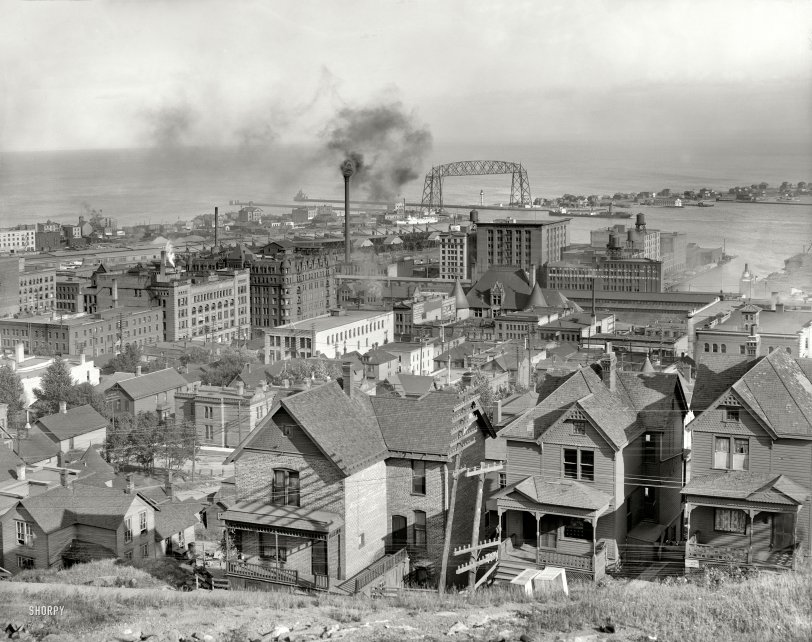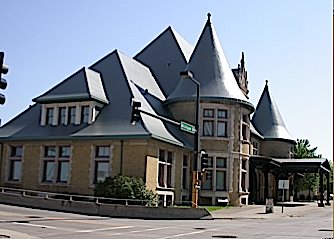


Framed or unframed, desk size to sofa size, printed by us in Arizona and Alabama since 2007. Explore now.
Shorpy is funded by you. Patreon contributors get an ad-free experience.
Learn more.

- Roll your own
- Rugged and real!
- A Charles Purcell - Mama Cass Connection
- Uncle SAAM
- Obfuscation
- One Chocolate Soldier rode away
- Victor Marquis de la Roche
- The Little House Across Way ...
- Vanderbilt Gates
- Vanderbilt Mansion
- You can still see that gate
- Withering heights for me
- So Jim,
- Top Heavy
- Re: Can't Place It.
- Bus ID
- Since you mention it
- The White Pages ?
- Moonlight Tower
- 1907?
- Fire(men) and Water
- Can't Place It
- Can anyone
- Wings
- Where's Claudette and Clark?
- Overbuilt Rolodex
- One song
- Give Me Wings Please!
- PRR
- Pinball Wizards
Printporium
Smoke on the Water: 1910

Duluth, Minnesota, circa 1905-1910. "Duluth from the Incline Railway." Another of the eerily depopulated hive-of-industry scenes that seemed to be a specialty of Detroit the Publishing Co. 8x10 inch dry plate glass negative. View full size.
3 Homes in the foreground
Drove by these houses today, 2 of the 3 houses in the foreground are still there, the middle wooden is gone. You can see them here via Google Street View: http://goo.gl/GQNqa3
Railroad Depot
The railroad depot in the center of the field is still there and now houses an excellent railroad museum.

The Two Passenger Vessels
The vessel to the far left, mostly obscured by the warehouse of the Stone Ordean Wells Company, is the Newsboy, a 104-foot wooden passenger steamer built 1889 by F. W. Wheeler & Company originally for service on Saginaw Bay. By 1902 she had migrated to the Zenith City and ran excursions inland on the St. Louis River to the picnic grounds at Fond du Lac. She ended her career on Lake Ontario, abandoned near Belleville, Ontario, in 1913. The larger steamer farther right is the Easton, built of steel in 1898 at Baltimore, Maryland, by Reeder & Company for service on Chesapeake Bay. She was brought to Lake Michigan in 1901 to carry passengers and fruit between Southwestern Michigan and Chicago. In 1903 she began service for the White Line Transportation Company, connecting Duluth with north shore Lake Superior ports, eventually being owned, as shown here, by the A. Booth Packing Company, supplying Booth's various Lake Superior fishing operations and transporting fish back to Duluth. In 1917 she was sold to the French government and taken across the Atlantic, converted to the naval patrol vessel Apache. In 1926 she was sold into civilian use and reconverted to a passenger and cargo steamer, renamed Le Sahel and operating out of Tunisia. She was broken up in 1938 at Bizerte, Tunisia, marking the end of a particularly peripatetic career.
Chamber of Commerce
- Kelley
- North Western Fuel Co.
- Peerless Laundry
- R.B. Knox & Co.
- Stone Ordean Wells Co. Wholesale Grocers, Manufacturers & Importers.
Pop. 1
I spy one person, I think, in the side doorway of the house at bottom left. For some reason, I find it amusing that 1910 Duluth had Turkish Baths. Seems so cosmopolitan for the Iron Range.
Where are the Trees?
Interesting (and sad) to see Park Point so devoid of trees. It's hard to imagine what it would have been like back then, given its current state of tall pines, and lush, abundant plant life.
It should also be noted that most of these buildings are still standing. Unlike other downtown areas of Minnesota, Duluth's original buildings didn't get mowed-down in favor of new, shiny ones. The city really retains some of its original character (good AND bad. But mostly Good).
Depopulated
Guess if you choose your angle so you don't photograph any streets it get easier to not show people. Also helps when folks aren't out on their porches.
I spy someone
Not quite depopulated -- there's a figure standing in the side doorway of that ramshakle house in the left foreground. By the way, what is up with the brick flues poking through the house's roof? It looks like every other brick is missing.
It's all gone
Replaced by the convention center and playfront/bayfront parks. The finger of land betwixt the channel and the lake is still residential though. And tell that kid in the doorway of the house at bottom left to quit staring at me.
Eerily depopulated?
I think of it as charmingly high in buildings-to-people ratio. My vision of a prosperous future is lots of built square feet per person. My vision of Blade Runner hell is lots of people per built square foot: "hive of humanity."

























On Shorpy:
Today’s Top 5